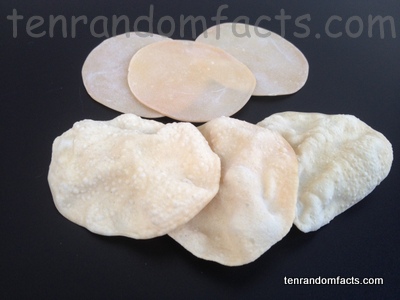The number of papadum spelling variations is enough to cover the actual recipe variations!
- Papadums are a thin, cracker or bread-like food made primarily of water and a type of flour, sometimes with the addition of oil and salt.
- A ‘papadum’ is also known as a ‘papad’, ‘pappadum’, ‘poppodum’, ‘pappadam’, ‘papari’ and ‘pāpar’, and there are countless other spelling variations.
- The flour used to make papadums varies and can include rice, black gram, lentil, potato or chickpea flour.
- In general, papadums are made by making a dough, and then cooking it by either toasting, deep frying, microwaving or roasting.
- Papadums are often eaten as an accompaniment to a main meal, such as a curry, or eaten as a snack; while condiments, vegetables, spices and/or curries may be placed on the cooked version before serving.
- Occasionally papadum dough is flavoured with spices, and they can be made in a wide variety of sizes.
- Papadums originated in India, Asia, where it is a particularly popular appetiser, and they are commonly used as a scoop in the process of eating Indian food, especially curry, and can be used to dull the spiciness of the food.
- Due to its inexpensive ingredients and ease in making, papadums are commonly made and sold by Indian females in their country, as a way to support their family.
- The texture of cooked papadums should be crispy, rough and somewhat bumpy; the bumpiness depending on the cooking style, though sometimes they are served soft like flat bread.
- Papadums are commonly available in supermarkets, and are sold cooked and ready to eat, or in a dried form ready to cook.
Bibliography:
Papadum, 2015, Wikipedia, https://en.wikipedia.org/wiki/Papadum
Papadum Bread, 2015, Recipe Tips, http://www.recipetips.com/glossary-term/t–37535/papadum-bread.asp
What is Papadum Bread?, 2015, WiseGEEK, http://www.wisegeek.com/what-is-papadum-bread.htm







